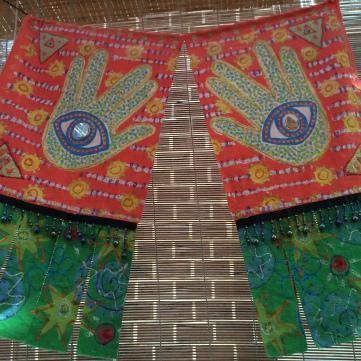
Philadelphia Sukkah, Leslie Sudock
How are interfaith families creating a new Jewish reality in America? That was the theme at the Interfaith Opportunity Summit in Philadelphia this week, organized by InterfaithFamily. The summit was attended by some 350 Jewish leaders: rabbis, Jewish educators, leading academics who study Judaism in America, and Jewish funders. I was honored to be invited to speak there about interfaith families celebrating both family religions.
I had just five minutes, and touched on these points:
- 25% of Jewish parents in interfaith relationships are raising children both, or “partially Jewish.” That’s more than the 20% raising interfaith children “Jewish only” by religion (Pew 2013). So the number of Jewish parents who want interfaith education for their interfaith children is significant, and growing.
- These “doing both” families want to engage with Judaism. So please engage with them, rather than excluding them from Jewish education because they also want interfaith education, or ignoring them with a “don’t ask, don’t tell” policy about the other religion in their lives.
- Interfaith families doing both already exist in many Jewish communities. So the question is not whether you should include them, but how to acknowledge their presence, engage with them, and learn from them.
- Rather than always asking about the difficulties and challenges, be open to hearing about the joys in interfaith families. Think about how your community can benefit from interfaith families as highly skilled bridge-builders and peacemakers.
- Jewish leaders would benefit from working hand-in-hand with clergy from other religions to support interfaith families, rather than competing for souls.
- Nothing about us without us! We need more adult interfaith children involved in organizing these conferences, speaking on the panels, telling our own stories, and shifting the frame into the reality of the present. That means listening not only to adult interfaith children who claim “just Jewish” identities, but also to those who have complex, fluid, flexible, intersectional “Jewish and” identities, including people who are multiple religious practitioners.
These messages echo my New York Times Op-Ed, published when my book Being Both, and the Pew Report on Jewish Americans, came out simultaneously in 2013. What has changed three years later is that now I am in touch with Jewish leaders from across the country who are working with “doing both” families, who feel less conflicted about the idea, and who see the logic of including rather than excluding people who want to be part of the greater Jewish community.
Going forward, it is clear that interfaith parents who want interfaith education for their interfaith children are going to play a larger role in the Jewish world. The next question is which of the Jewish funding organizations at the summit will be visionary enough to invest in helping clergy, educators, seminaries, and Jewish communities to engage with this new reality. I stand ready to help, as a guide and interpreter, and as someone who has been thinking about these issues for a lifetime now.
(For more on the summit, see my tweets from the day on Storify here)
Susan Katz Miller is the author of Being Both: Embracing Two Religions in One Interfaith Family, from Beacon Press. She works as an interfaith families consultant, speaker, and coach. Follow her on twitter @beingboth.

